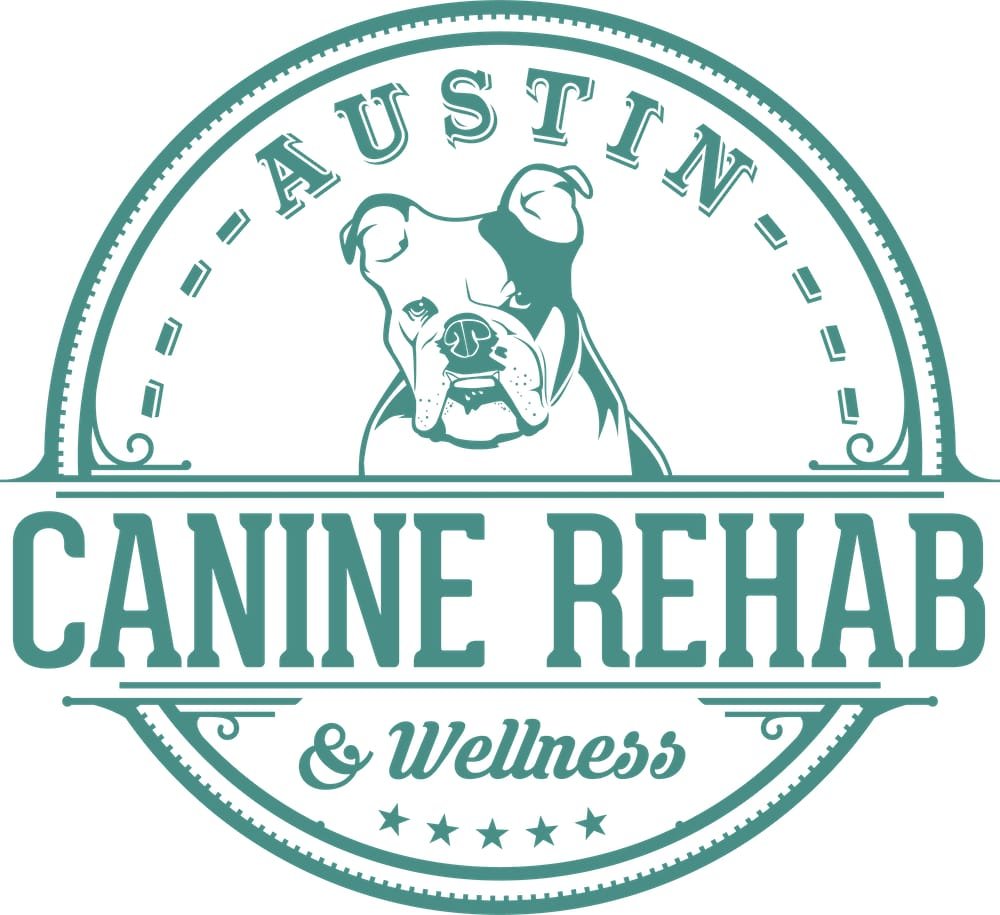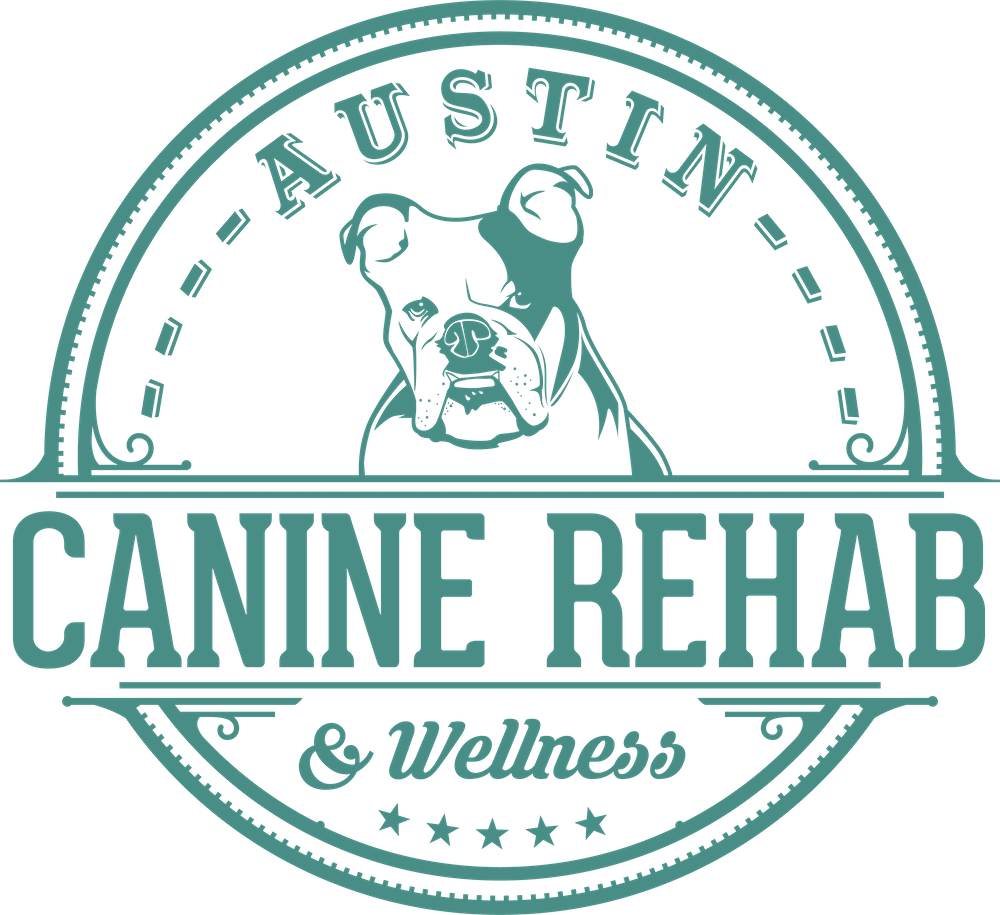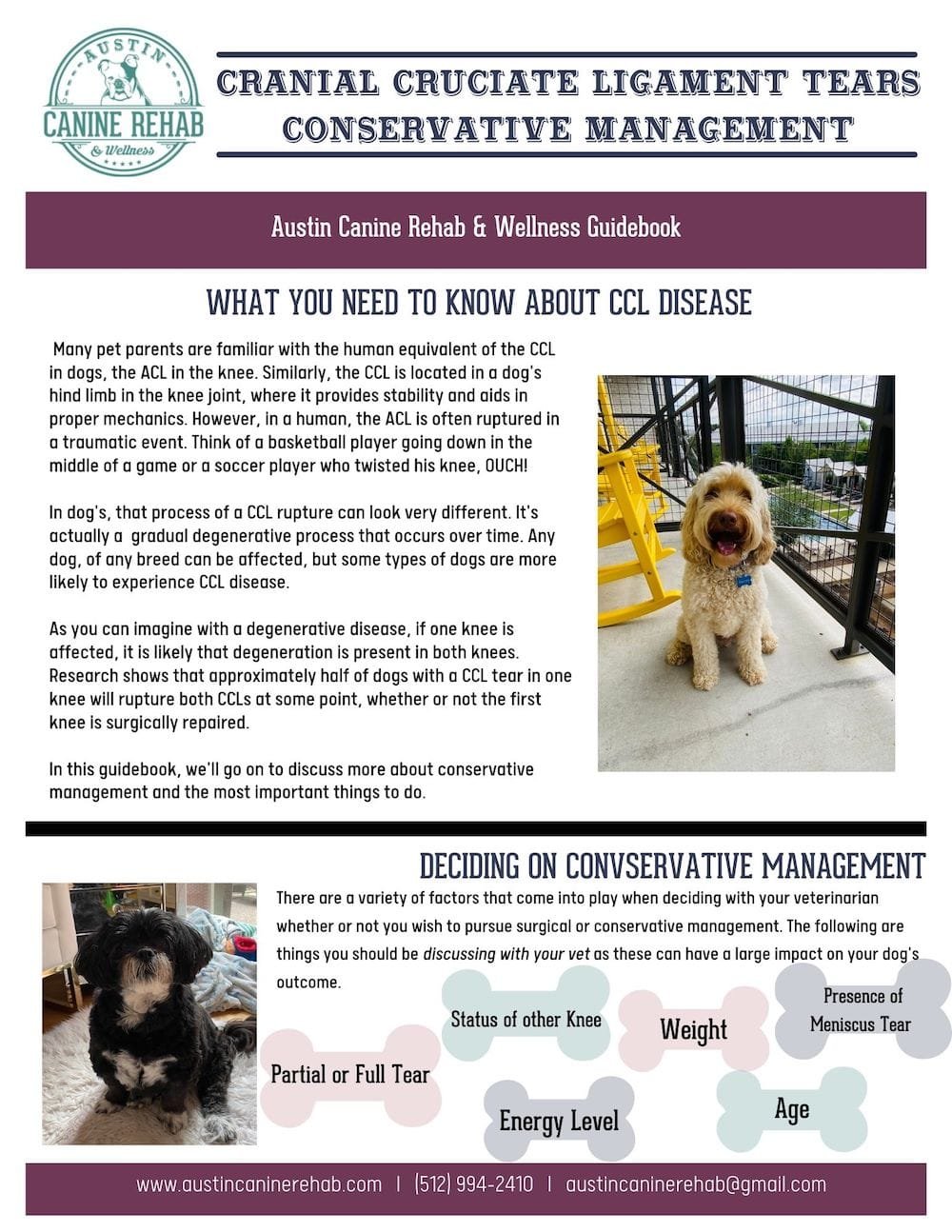CCL Tears in Dogs: Post-Surgical Management
ACL Surgery in Dogs
Sometimes surgery is the best option for a dog with a torn ACL/CCL. We’ll cover the surgical options, how they differ, and most importantly what to do for your dog AFTER surgery!
If you haven’t already, hop on over to the CCL Tears in Dogs blog post to learn more about the ACL/CCL in dogs. It’s important to know what the CCL is and its purpose in order to understand the surgical options and be an informed pet parent.
Since the CCL lends stability to a dog’s knee joint, all the surgical options will center around returning the knee to a biomechanically stable position. Remember, that without an intact CCL, the tibia or lower leg will jut forward when the dog is weight bearing through the leg whether in standing or during walking. There are several different surgical options and they all differ on how they provide that much needed stability to the knee joint.
What factors determine the need for surgery?
Your vet will perform a hands-on assessment which is often followed up with imaging to confirm their suspicions. They will then provide you with a definitive diagnosis of a partial or full CCL tear. Your vet will make their recommendations for surgery based on your dog’s overall health, age and whether your dog has a full tear, partial tear, or meniscal involvement.
The meniscus is often talked about in human rehab during an ACL rupture, because it can have a huge affect on healing if not dealt with. The same is true for dogs! The meniscus acts as a shock abosorber between the femur (thigh bone) and the tibia (lower leg bone). If the meniscus is torn (this can happen before or after the initial injury or surgery) then your dog will need surgery to repair this and conservative management becomes a less likely option.
Other factors include:
Status of the other knee
Is the ACL intact or ruptured as well?
The dog’s lifestyle
Do they participate in agility?
Are they a couch potato?
Is hiking one of their favorite activities to do with you?
Bodyweight
Could your pup stand to lose some weight?
Surgical Options of ACL Tears
Extracapsular Repairs
Extracapsular repair surgeries replace the cranial cruciate ligament with something else that does the same job as the CCL, thereby providing static stabilization of the knee joint. These were more common in the past, but you will still see them performed today. Extracapsular repairs are less invasive and that is a main contributing factor to this approach being chosen for a CCL tear in dogs.
A “tightrope” surgery is a good example of a extracapsular repair, where small holes are drilled into the femur and tibia and a synthetic fiber is strung through the holes to recreate the stability provided by the CCL.
Another example of an extracapsular surgery is the lateral suture stabilization approach wherein a small medical grade fishing line material connects the fabella (a small bone located in the proximal calf muscle near the knee joint) to the tibia. This surgery relies on the buildup of scar tissue post-surgically in order to provide stability. This is usually only recommended for small dog breeds.
Tibial Plateau Levelling Osteotomy (TPLO)
One of the most common surgeries done today, a TPLO surgery has a great success rate and is often used in more active dogs and large breeds to ensure return to sport/activity. During TPLO surgery, the angle of the tibial plateau is leveled, so that the femur can no longer slide off the tibia.
To get a full picture of how a TPLO surgery might help your dog, check out this video series by the Veterinary Surgeons at TPLO Austin.
It features 6 videos covering everything from anatomy and diagnosis to surgery and recovery. 1
Tibial Tuberosity Advancement (TTA)
If there is meniscal involvement, the TTA approach is often used. In a TTA surgery, the front part of the tibia is advanced forward, altering the pull of the patellar ligament. This changes the biomechanic properties of the knee and offers increased dynamic stability to the joint.
Recent research suggests that there may be more significant development of osteoarthritis following a TTA as compared to a TPLO, so long term results must be considered as well when choosing a surgical procedure. 2
Other Things to Consider
Your veterinarian or surgeon may suggest the surgical approach they are most comfortable with. Your veterinarian will have highly educated thoughts on which surgery they feel is best for your dog, but don’t be afraid to seek a second opinion if you feel it’s necessary. Even I have my own biased leanings based on my education on the topic and professional experiences with recovery from different surgical approaches. It’s important that we acknowledge the biases we and/or our veterinary surgeon may have, in order to make the most informed decision.
We also don’t live in a perfect world! There is no perfect surgery and no guaranteed outcome, but we do our best with the information available to us.
Recovery After ACL Surgery in Dogs
No one wants their pup to go through surgery! But sometimes it is the best way to move forward and get your dog back in the action. One thing we do know about post-surgical care of a CCL/ACL tear in dogs is that a controlled and progressive rehabilitation program is essential. And you don’t have to wait till weeks out to get started! In the human world, a patient who let’s say underwent a total knee replacement, would be in rehab that same day, doing stairs! That’s how important early movement is in the healing process. Well it’s the same for dogs, and while we aren’t suggesting you take your dog up stairs right after surgery, it is important to implement an appropriate rehab protocol early on.
Let’s talk about the age old prescription of crate rest following surgery. Crate rate is suggestive of only ever letting your dog out of the crate for potty breaks, otherwise all time is spent within the crate. This sounds absolutely terrible doesn’t it! How will I keep my super active pup entertained? Wouldn’t you go stir crazy too if someone tied you to a bed after surgery for weeks? Instead we suggest active rest!
Active rest is something else entirely. With active rest, your dog is able to get out of the crate, participate safely in therapy and spend time with you. Mental stimulation activities can also be engaged in, helping to soothe that active doggy brain.
Let’s also talk about weight bearing. We need to get your dog weight bearing through their surgical leg as soon as possible! Remember how approximately 50% of dogs will go on to tear the ACL on the other leg… well the more stress they put on their good leg, the more likely this can occur.
To learn more about the recovery process for your dog, speak with a Certified Canine Rehabilitation Therapist today. They are uniquely qualified through education and experience to assess your dog’s specific needs and develop a plan of care based solely on your dog. Active rest and early weight bearing are just the tip of the iceberg. Don’t settle for cookie cutter rehab, your pup deserves the best!
Still not sure if surgery is right for your pup?
Check out the CCL/ACL conservative management guide to learn more about what to expect!
References:
TPLO surgery in Austin, TX. TPLO Austin. (2021, October 29). Retrieved November 13, 2021, from https://tploaustin.com/.
Moore EV, Weeren R, Paek M. Extended long-term radiographic and functional comparison of tibial plateau leveling osteotomy vs tibial tuberosity advancement for cranial cruciate ligament rupture in the dog. Vet Surg. 2020;49(1):146-154. doi:10.1111/vsu.13277


